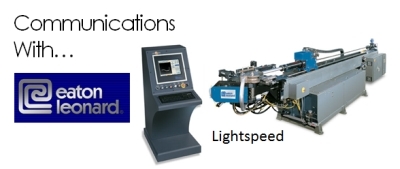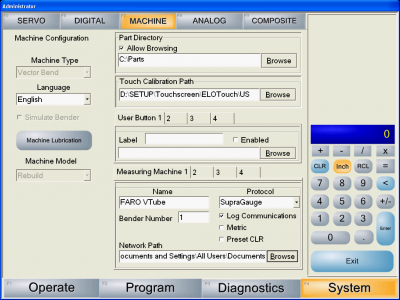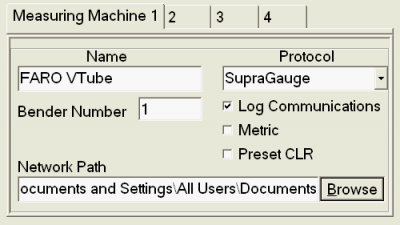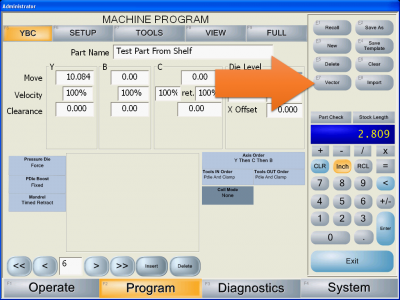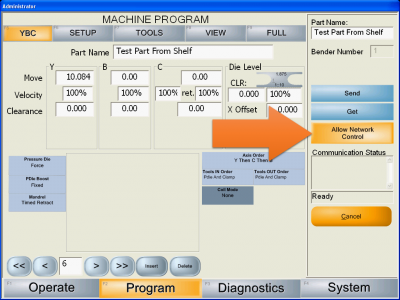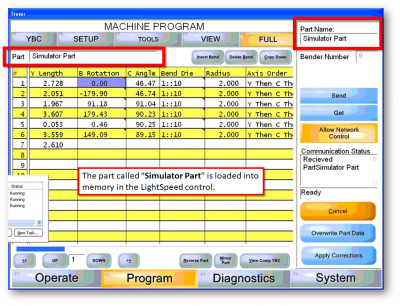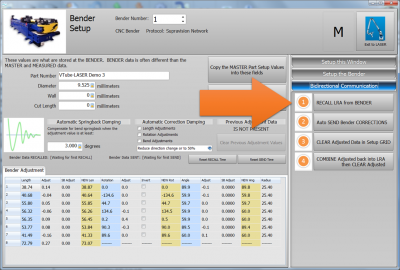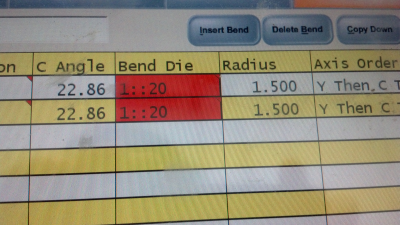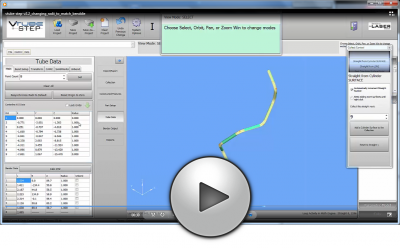Difference between revisions of "Eaton Leonard Lightspeed Communications Setup"
(→VTube-LASER Communications Test With the LightSpeed) |
(→VTube-LASER Communications Test With LightSpeed) |
||
| Line 75: | Line 75: | ||
</table> | </table> | ||
<br><br> | <br><br> | ||
| + | |||
| + | ==VTube-STEP Communications Test With LightSpeed== | ||
| + | |||
| + | VTube-STEP is the version of VTube that allows you to send data from a model to a bender. (VTube-LASER can SEND and RECALL. See the VTube-LASER section below.) This section is for testing the LightSpeed control with with VTube-STEP.<br><br> | ||
| + | |||
| + | In order to communicate with the LightSpeed control, it's necessary to switch on remote communications in the control in the user interface.<br><br> | ||
| + | |||
| + | ===STEP 1: Exit AUTO Mode=== | ||
| + | <table> | ||
| + | |||
| + | <tr> | ||
| + | <td width="300" valign=top> | ||
| + | Be sure to exit AUTO mode if that is the mode it is currently in. LightSpeed does not communicate if it is in AUTO mode. | ||
| + | </td> | ||
| + | <td> | ||
| + | </td> | ||
| + | </tr> | ||
| + | |||
| + | </table> | ||
| + | |||
| + | ===STEP 2: Enter the Vector Menu=== | ||
| + | <table> | ||
| + | |||
| + | <tr> | ||
| + | <td width="300" valign=top> | ||
| + | Click on the "Vector" button on the right side of the screen.<br><br> | ||
| + | </td> | ||
| + | <td> | ||
| + | [[image:LightSpeed_ProgramScreen_VectorButton.png|400px]] | ||
| + | </td> | ||
| + | </tr> | ||
| + | |||
| + | </table> | ||
| + | |||
| + | |||
| + | ===STEP 3: Choose the VMM for VTube=== | ||
| + | <table> | ||
| + | |||
| + | <tr> | ||
| + | <td width="300" valign=top> | ||
| + | Newer versions of LightSpeed let you choose which measuring center to communicate with.<br><br> | ||
| + | Choose the VTube option. | ||
| + | </td> | ||
| + | <td> | ||
| + | [[image:LightSpeed_VMM_Choice.png|400px]] | ||
| + | </td> | ||
| + | </tr> | ||
| + | |||
| + | </table> | ||
| + | |||
| + | ===STEP 4: Allow Network Control=== | ||
| + | <table> | ||
| + | |||
| + | <tr> | ||
| + | <td width="300" valign=top> | ||
| + | In the VECTOR menu, press the "Allow Network Control" button until it turns orange. (Orange indicates that it is toggled on.)<br><br> | ||
| + | </td> | ||
| + | <td valign=top> | ||
| + | [[image:LightSpeed_ProgramScreen_AllowNetworkControl.png|400px]]<br><br> | ||
| + | </td> | ||
| + | </tr> | ||
| + | |||
| + | </table> | ||
| + | <br><br> | ||
| + | |||
| + | ===STEP 5: SEND a Part from the VTube-LASER=== | ||
| + | <table> | ||
| + | |||
| + | <tr> | ||
| + | <td width="300" valign=top> | ||
| + | From the measuring center, send a part to the LightSpeed. (This assumes that the connection has been made and that the SVNET protcol is being used, and that the appropriate bender number is used at the measuring center.<br><br> | ||
| + | |||
| + | The screen on the right shows an example Bender Setup screen in [[VTube-LASER]] for communication.<br><br> | ||
| + | To send new data, choose the bender number, set the Part Number (if it is not, enter the "Bender Setup" menu, and press the AUTO SEND button.<br><br> | ||
| + | '''Keep in mind that the PART NUMBER value in VTube is the name that will be used by the LightSpeed to save the part data that it received.''' | ||
| + | </td> | ||
| + | <td valign=top> | ||
| + | [[image:vtube-laser_v2.2_bendersetup_sendbluecolumns.png|400px]]<br><br> | ||
| + | </td> | ||
| + | </tr> | ||
| + | |||
| + | </table> | ||
| + | <br><br> | ||
| + | |||
| + | ===STEP 6: Observe the LightSpeed Communications Status Box=== | ||
| + | <table> | ||
| + | |||
| + | <tr> | ||
| + | <td width="300" valign=top> | ||
| + | The Communications Status box in the LightSpeed Vector menu should show activity - like that the incoming file was saved.<br><br>You will also see the options of Overwriting the part data, or Importing the YBC data only. Overwriting the part data will allow the new data to completely overwrite the part in memory. Pressing the YBC data only will change only the YBC data in memory with the incoming data.<br><br> | ||
| + | For setting up a new part, you can press overwrite. For corrections you can press YBC data only.<br><br> | ||
| + | In this test, press Overwrite Part Data.<br><br> | ||
| + | If you press Overwrite the Part Data, then LightSpeed will clear the current setup and clear the Tools. A tool set will need to be recalled to clear the red cells in the ALL page Bend Die column. | ||
| + | </td> | ||
| + | <td valign=top> | ||
| + | [[image:LightSpeed_ProgramScreen_ReceivedData2.png|400px]]<br><br> | ||
| + | </td> | ||
| + | </tr> | ||
| + | |||
| + | </table> | ||
| + | <br><br> | ||
| + | |||
| + | ===STEP 7: Perform a RECALL at VTube-LASER=== | ||
| + | <table> | ||
| + | |||
| + | <tr> | ||
| + | <td width="300" valign=top> | ||
| + | Change any value in the YBC data. Make the value change easily recognizable for when we recall the data in VTube-LASER.<br><br> | ||
| + | Now, at VTube-LASER press RECALL. LightSpeed should answer VTube-LASER with the new data in the blue columns.<br><br> | ||
| + | If the new values are displayed in the blue LRA columns, then the communication was successful. | ||
| + | </td> | ||
| + | <td valign=top> | ||
| + | [[image:vtube-laser_v2.2_bendersetup_recall_lra_from_bender.png|400px]]<br><br> | ||
| + | </td> | ||
| + | </tr> | ||
| + | |||
| + | </table> | ||
| + | <br><br> | ||
| + | |||
| + | |||
| + | |||
==VTube-LASER Communications Test With LightSpeed== | ==VTube-LASER Communications Test With LightSpeed== | ||
Revision as of 21:34, 18 December 2015
|
This document outlines the basic communications setup for a Lightspeed control. |
|
|
Network Communications Setup Instructions for the Eaton Leonard LIGHTSPEED
|
This is good for use in connecting with our VTube-LASER, VTube-STEP, and Benderlink software packages. All of them are equipped with the Supravision Network protocol - which is a protocol LightSpeed understands. |
STEP 1: System Menu and Administrative Control
|
Change to the Systems menu. If you are not running the operator station as an administrator, then press SECURITY and enter the administrator code. (The default code is "123".) Press the DEVICE CONFIG button. |
STEP 2: Device Config / Machine Menu
|
In DEVICE CONFIG, enter the MACHINE menu. Select a Measure Machine tab. LightSpeed can store four simultaneous measuring center setups for connection to multiple measuring centers.
|
VTube-STEP Communications Test With LightSpeed
VTube-STEP is the version of VTube that allows you to send data from a model to a bender. (VTube-LASER can SEND and RECALL. See the VTube-LASER section below.) This section is for testing the LightSpeed control with with VTube-STEP.
In order to communicate with the LightSpeed control, it's necessary to switch on remote communications in the control in the user interface.
STEP 1: Exit AUTO Mode
|
Be sure to exit AUTO mode if that is the mode it is currently in. LightSpeed does not communicate if it is in AUTO mode. |
STEP 2: Enter the Vector Menu
|
Click on the "Vector" button on the right side of the screen. |
STEP 3: Choose the VMM for VTube
|
Newer versions of LightSpeed let you choose which measuring center to communicate with. |
STEP 4: Allow Network Control
|
In the VECTOR menu, press the "Allow Network Control" button until it turns orange. (Orange indicates that it is toggled on.) |
STEP 5: SEND a Part from the VTube-LASER
|
From the measuring center, send a part to the LightSpeed. (This assumes that the connection has been made and that the SVNET protcol is being used, and that the appropriate bender number is used at the measuring center. The screen on the right shows an example Bender Setup screen in VTube-LASER for communication. |
STEP 6: Observe the LightSpeed Communications Status Box
|
The Communications Status box in the LightSpeed Vector menu should show activity - like that the incoming file was saved. |
STEP 7: Perform a RECALL at VTube-LASER
|
Change any value in the YBC data. Make the value change easily recognizable for when we recall the data in VTube-LASER. |
VTube-LASER Communications Test With LightSpeed
VTube-LASER is the version of VTube that communicates with a FARO arm in order to measure tubes and correct benders. It's communications capabilities are more sophisticated than VTube-STEP. VTube-STEP can send data to the bender. VTube-LASER can SEND and RECALL. This section is for testingthe LightSpeed control with with VTube-LASER.
In order to communicate with the LightSpeed control, it's necessary to switch on remote communications in the control in the user interface.
STEP 1: Exit AUTO Mode
|
Be sure to exit AUTO mode if that is the mode it is currently in. LightSpeed does not communicate if it is in AUTO mode. |
STEP 2: Enter the Vector Menu
|
Click on the "Vector" button on the right side of the screen. |
STEP 3: Choose the VMM for VTube
|
Newer versions of LightSpeed let you choose which measuring center to communicate with. |
STEP 4: Allow Network Control
|
In the VECTOR menu, press the "Allow Network Control" button until it turns orange. (Orange indicates that it is toggled on.) |
STEP 5: SEND a Part from the VTube-LASER
|
From the measuring center, send a part to the LightSpeed. (This assumes that the connection has been made and that the SVNET protcol is being used, and that the appropriate bender number is used at the measuring center. The screen on the right shows an example Bender Setup screen in VTube-LASER for communication. |
STEP 6: Observe the LightSpeed Communications Status Box
|
The Communications Status box in the LightSpeed Vector menu should show activity - like that the incoming file was saved. |
STEP 7: Perform a RECALL at VTube-LASER
|
Change any value in the YBC data. Make the value change easily recognizable for when we recall the data in VTube-LASER. |
Solving LightSpeed Bend Die / Incoming RADIUS Mismatch Issue
|
If you send a part to the LightSpeed that has dies that do not match the current die setup, then the Bend Die columns in the VIEW page will turn red - indicating a problem. |
SOLUTION 1: Change the Radius Values in VTube before Sending Data
|
It's easy to change the radius values for a tube model before sending the data to the bender. In the video example, you will see a radius value of 1". However, in the Eaton Leonard LightSpeed, the die centerline radius is 1.125". So, just before sending data to the bender, we change the radius to match the bend die on the bender. This does not change the shape of the tube in space. It only changes the lengths between bends. |
SOLUTION 2: Be sure the TOOLS Page Is Setup With Non Zero Values
|
When you clear a part, the process also can clear the tool page so that all the values are reset to zero. The image on the right shows what happens after clear of a program in the LightSpeed |
SOLUTION 3: Be sure the YBC Page CENTERLINE RADIUS Values Match the TOOL Page Values
Other Pages
|
